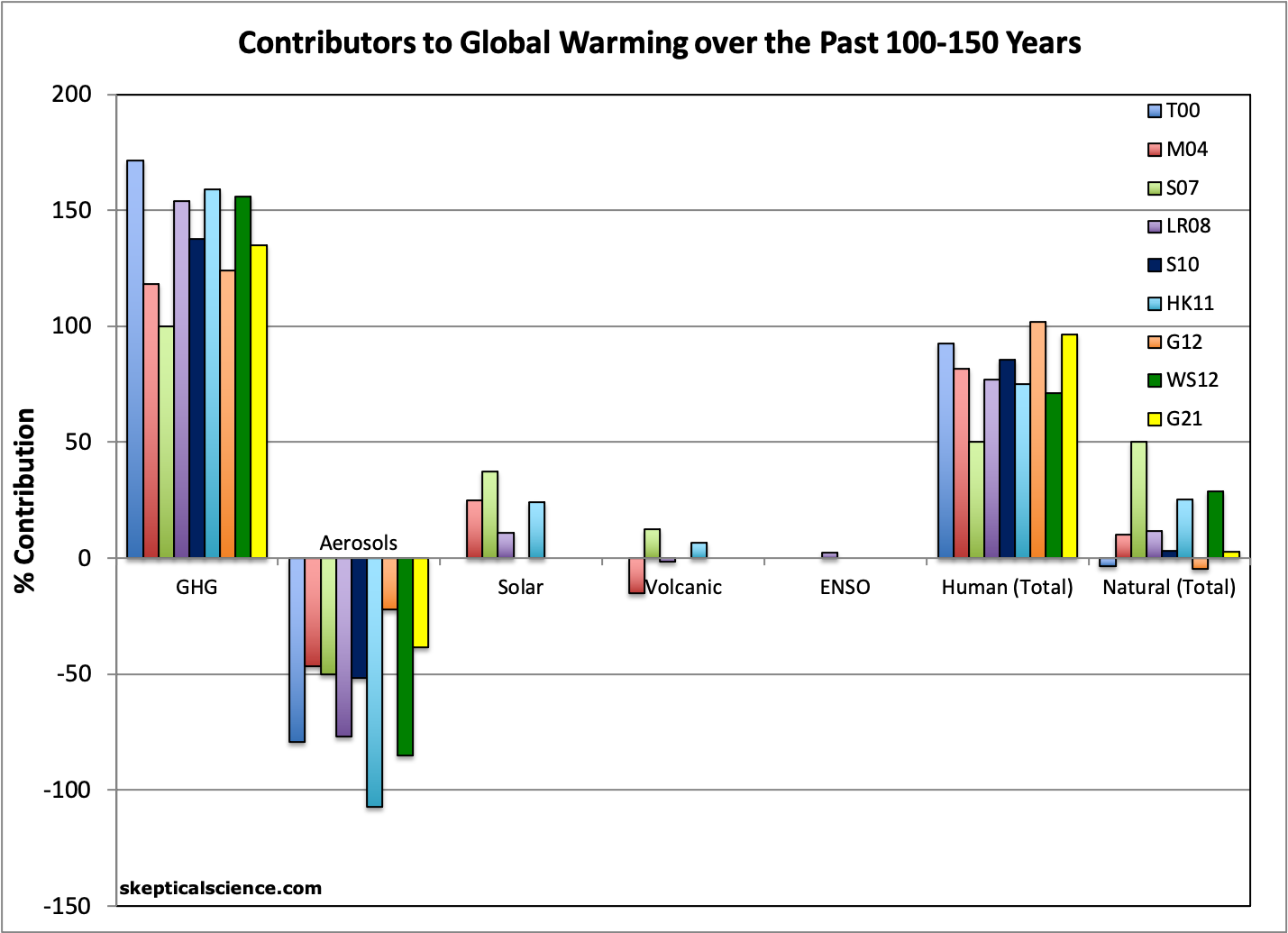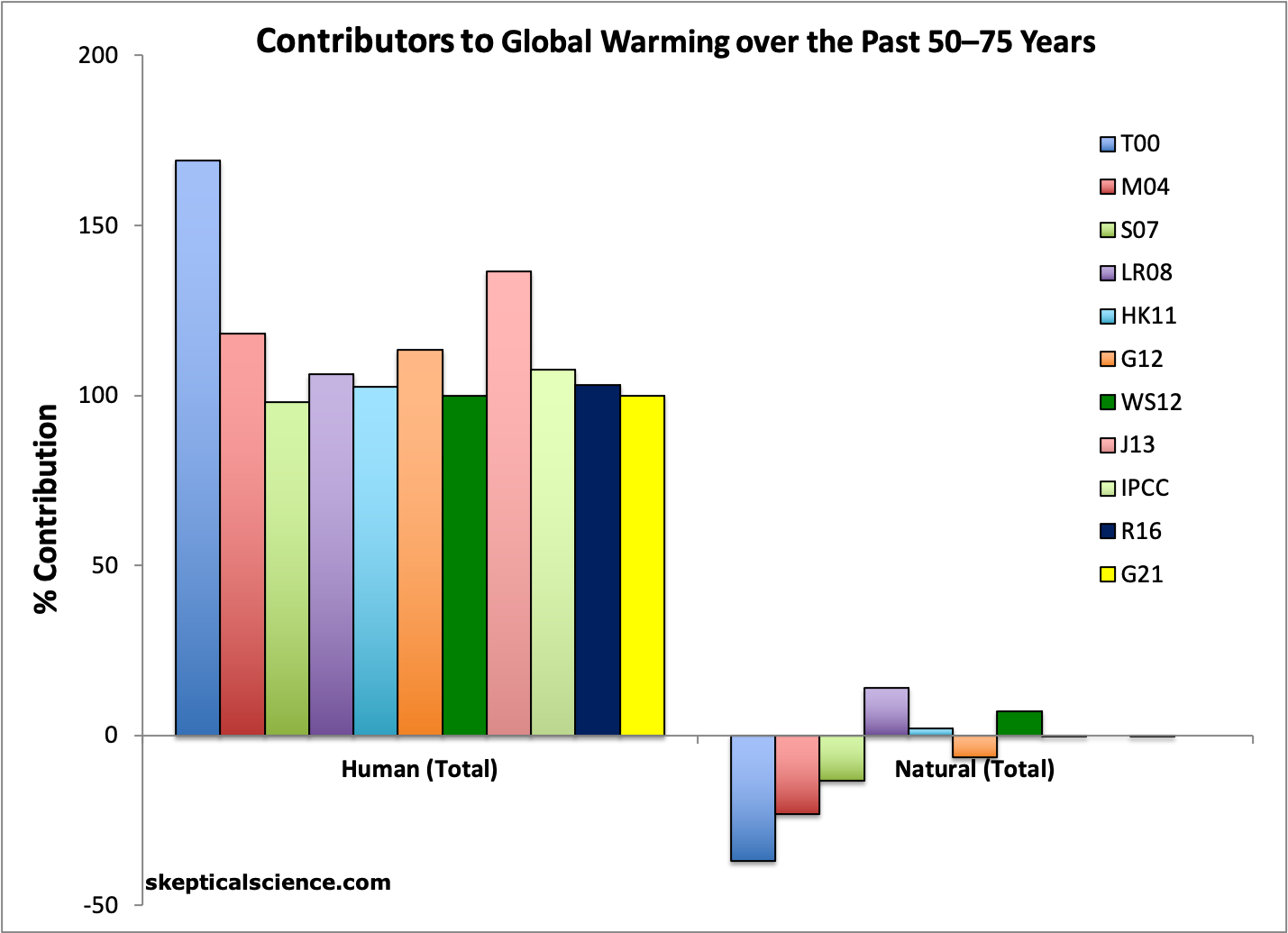Gillett et al. (2021) global warming attribution study
Posted on 19 January 2021 by dana1981
The Human vs. Natural Contributions to Global Warming chart on the Skeptical Science Graphics Page has been updated to include the study discussed below
A new study published in Nature Climate Change, Gillett et al. (2021), is the latest in a long line of 'detection and attribution' studies published over the past 20-plus years that have sought to quantify the factors responsible for the rise in average global surface temperatures.
Gillett et al. used Detection and Attribution Model Intercomparison Project simulations from 13 Coupled Model Intercomparison Project Phase 6 (CMIP6) models. The authors note that the CMIP6 historical simulations "show very little net anthropogenic warming before the 1960s. This contrasts with the CMIP5 historical simulations, which showed on average approximately 0.2°C warming by the mid-twentieth century."
To determine the attribution of the observed global surface warming of 1.1°C between the late 19th Century and the past decade, the authors performed a variant of linear regression – an optimal detection analysis using a regularized optimal fingerprinting algorithm. They conclude:
"anthropogenic forcings caused 0.9 to 1.3°C of warming in global mean near-surface air temperature in 2010–2019 relative to 1850–1900, compared with an observed warming of 1.1°C. Greenhouse gases and aerosols contributed changes of 1.2 to 1.9°C and −0.7 to −0.1°C, respectively, and natural forcings contributed negligibly. These results demonstrate the substantial human influence on climate so far and the urgency of action needed to meet the Paris Agreement goals."
In short, humans are responsible for close to 100% of global surface warming over the past 150 years. Specifically, based on their central attribution estimates, greenhouse gases are responsible for about 1.54°C (135%) of the warming, offset by 0.44°C cooling from aerosols (-38%), plus around 0.03°C warming from natural effects (3%). The Gillett et al. (2021) results are illustrated by the yellow bars in the charts below (note that they didn't break out the various [solar/volcanic/ENSO] natural factors in this study, as some others have).

Factors attributed to causing average global surface warming since the late 19th Century by various studies, including Tett et al. 2000 (T00, dark blue), Meehl et al. 2004 (M04, red), Stone et al. 2007 (S07, light green), Lean and Rind 2008 (LR08, purple), Huber and Knutti 2011 (HK11, light blue), Gillett et al. 2012 (G12, orange), Wigley and Santer 2012 (WG12, dark green), and Gillett et al. 2021 (G21, yellow).
Looking at the warming since the mid-20th Century (close to 0.9°C), we see a similar story: warming from greenhouse gases of about 1.1°C (125%), offset by around 0.2°C cooling from aerosols (-25%), and essentially no net temperature influence from natural factors.

Factors attributed to causing average global surface warming since the mid-20th Century by various studies, including Tett et al. 2000 (T00, dark blue), Meehl et al. 2004 (M04, red), Stone et al. 2007 (S07, green), Lean and Rind 2008 (LR08, purple), Huber and Knutti 2011 (HK11, light blue), Gillett et al. 2012 (G12, orange), Wigley and Santer 2012 (WG12, dark green), Jones et al. 2013 (J13, pink), IPCC AR5 (IPCC, light green), Ribes et al. 2016 (R16, dark blue), and Gillett et al. 2021 (G21, yellow).
The studies paint a consistent picture – human fossil fuel pollution is responsible for all of the global warming since 1950, and if Gillett et al. (2021) are correct, potentially all of the warming since the Industrial Revolution.































 Arguments
Arguments






























I am an engineer by training and experience, so I do have a scientific
background. At this time, I want to point out a few scientific facts. The first
is from a text on historical geology. They list all of the geologic divisions
from the permian going back about 350my to the cambrian. We know
that most of the carbon that is sequestered in geologic formations was
deposited as coal, limestone and shale during that period. Also the
atmosphere benefited by O2. I think it is obvious that the process would
have required a lot of CO2, which everone knows is the product of
volcanic action. I cannot imagine that any scientist would alledge that
CO2 has the power to drive the process, but be my guest.
James h. shanley, environmental safety engineer
I appologe for the snarky remark. Will abide with the rules next time.
[PS] Offtopic. Maybe start with "Co2 levels were higher in the past" but more detail on past CO2 and past climate on many other threads. Use the Search button on top left or review the "Arguments" page.
Jasmesh:
Your statement " I cannot imagine..." is an argument from incredulity. It carries no weight. I don't even know what "the process" is that you are talking about.
If you have specific things to state related to specific aspects of climate science, please use the Search function to find a topic, and place comments on that topic.
Your comments should deal with something raised by the blog post - if not, it's probably off topic there and you need to find another topic. This topic does not discuss distant geological time - only the recent past.
James... If I understand your question correctly, this might be a better thread to comment on. John Mason does a good explanation of carbonate-silicate rock weathering thermostat processes here:
https://skepticalscience.com/weathering.html
Bob
My intent was to engage our audience in a discution of scientific facts.
The central issue is climate forcing by atmospheric CO2. The term was
used by Dr. Mann in his publication dated 01 April 19 Titled Global-scale
temperature patterns and climate forcing. I think it is fair to look at the
science behind climate forcing. My purpose in citing geologic history
was to illustrate a long period when CO2 in the atmosphere could not
have forced the sequesteration of carbon in the earths sedimentary
rocks. Inasmuch as the physical laws of nature haven't change I figured
scientists might agree that CO2 in the atmosphere could not possibly
force climate change. To confirm the foregoing alledge fact, anyone
can go online and with the aid of google, find that N2 is also a GHG
and that it is 300 times more effective than CO2. All of this does make
if one keeps in mind that at 400ppm CO2 is present in the atmosphere
that it weights in at o.o4 percent. N2 comes in at 80percent. If we go
to the driest place on earth, probably the Sahara, we are told that night
temps. are known to drop as much as 36deg F. The moderating effects
of H2 and CO2 are nowhere to be found. Also there was an opportunity
to run a GHG test on effecity of CO2 by running a series of tests, starting
with sundown and running to sunup. A series could have been run, but
it was not done. Again, I am not looking to engage any one person
specificately, I only want to discuss the scientific facts (as I see them)
[TD] Your comment is off topic, as was your previous one. Find appropriate posts for your comments, with separate comments on separate posts.
For your claim that N2 is a greenhouse gas, you should read the American Chemical Society's post "Which Gases are Greenhouse Gases?", and if for some reason you disagree with the absence of N2's listing there, maybe post your objection in the SkepticalScience thread off the post "CO2 is main driver of climate change."
You must also back up your claims with evidence. For example, your claim that CO2 and H2O do not affect temperatures of deserts plainly is false, but if you want to claim otherwise you need to provide evidence, along with whatever rationale you can muster for squaring that claim of yours with your note that deserts are dry. I for one cannot figure out how the cooling of a desert with a dearth of water vapor demonstrates that the presence of water vapor fails to prevent cooling.
Rob
I think you missed my point. My purpose was to address the scientific
basis for Climate forcing. I think this is a valid issue, inasmuch as DR.
Mann raised the issue in his paper titled Global-scale temperature
patterns and climate forcing etc. published 01 April 1998. I do'not
want to address my concerns to anyone in particular, I just want to
talk about applicable science.
[PS] Take this to an appropriate thread. No more offtopic comments here please. You have already been pointed to more appropriate thread. Take the time to read the science before commenting.
Hi Jamesh,
If you want to engage successfully it helps if you do some background reading first. For example, diatomic molecules like N2 (78% of atmosphere) and O2 (21%) do not absorb IR radiation and are not greenhouse gasses. (Monoatomic atoms like argon (0.9%) also are not greenhouse gasses). This is a pretty basic mistake and makes everything else you say look questionable. Triatomic molecules like H2O and CO2 and higher order molecules like SF6 absorb IR radiation and are greenhouse gasses (< 0.1%). This was figured out by scientists in about 1850.
Good luck in your effort. I suggest you read some of the basics first like the Interactive History of Climate Science at the upper left of this page.
michael sweet @7,
In calling N2 "a GHG and that it is 300 times more effective than CO2," the commenter @5 is probably in this particular confusing N2 and N2O, the latter of course being a GHG and with current atmospheric concentrations, providing 10% of the forcing level of CO2 from 2000-times less increase in oncentration. The "300 times more potent than carbon dioxide" can often be found on-line, this being a rounded-up value for the 100 year GWP.
jamesh@5:
You are not expressing yourself sufficeintly clearly. For example, you first say
[emphasis mine], and then you say:
The two uses of the term "force" have entirely different meanings in these contexts.
Mann's statement - and any statement that has to do with CO2 forcing climate changes - is due to the radiative properties of greenhouse gases. They absorb and emit IR radaition, which alters the flows of energy, and do this in such a fashion that the global balance between absorbed solar radiation and emitted IR (to space) is affected. As a result, the earth warms in response to increased atmospheric CO2.
In your second use of the term forced, you seem to be talking about changes in the global carbon cycle. How the carbon cycle responds to the burning of fossil fuels is a different question from how increased atmospheric CO2 alters the radiation transfer.
To claim that CO2 cannot force climate because the atmosphere cannot force geological carbon sequestration is a non sequitur.
There are threads her that discuss the carbon cycle and how we know that the burning of fossil fuels is leading to increased atmospheric CO2. There are other threads where the role of CO2 as a greenhouse gas is discussed, including how the greenhouse gases lead to a warmer surface.
Such confusion in what you write needs to be clarified. We can only know your thoughts by how you express them. If your writing is confusing, we have no way of knowing if you are just expressing yourself poorly, or whether you are failing to understand some aspect of the science. Right now, it looks like there is a lot you do not understand.